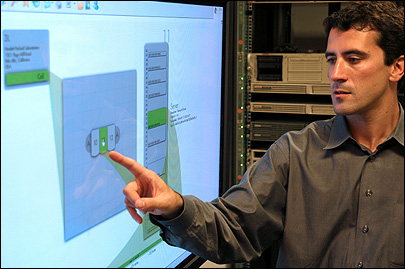Computer products and services firm Hewlett-Packard (HP) has announced a new technology application developed by its R&D arm, HP Labs in Palo Alto, Calif. This new app is designed to give companies better visibility of, and control over, their IT assets housed in HP server racks. As a proof-of-concept test bed for the system, Midwestern grocery chain Meijer offered up HP blade-server racks deployed at its Grand Rapids, Mich., data center.
HP says it is still testing and evaluating the system and has not yet set a release date or pricing information. The company believes this is the first RFID-based, real-time IP asset-tracking system able to pinpoint the location of an asset to its slot inside a server rack.
The system is based on an ISO-standard passive RFID tag attached to each server, router switch or other IT component installed in an HP server rack. The rack is outfitted with an RFID interrogator that can sense the location of each tag to its exact slot location in the rack, says Cyril Brignone, project manager at HP Labs. Making these tags readable inside the metal rack—which essentially acts as a large Faraday cage, blocking RF electromagnetic radiation—required an innovative approach. In the interest of protecting HP’s intellectual property, Brignone declined to reveal any further tag, reader or configuration specifics.
The system’s main benefits for Meijer and other users are two-fold. It can generate a constantly updated inventory of the tagged contents of each rack. This visibility also serves a security function, by accounting for (or alerting users to the absence of) servers containing sensitive business data. “We have 600 Windows servers here,” says Tim Osbeck, manager of operations and technical support for Meijer, “and it’s always good to know where they are.”
Osbeck says he and his team were impressed with the RFID system’s ease of implementation and use, and that Meijer would consider deploying it permanently if it becomes commercially available. Currently, Meijer’s approach to inventorying its IT assets consists of an employee making a manual checklist that is then keyed into a spreadsheet. This manual approach is time-consuming and prone to error. Moreover, whenever anyone needs to remove an asset from a rack—such as for repair or reconfiguration—there is no way to update the asset’s status automatically.
The HP system tracks the time and date each tagged asset is removed from the rack. This, combined with the inventory data, could make it easier for Meijer to comply with the credit-card industry’s requirements for asset accountability. “We already have multiple layers of security,” Osbeck explains, “but this would give more specific data about the security of racks. We could show that a rack has not been opened in the last 60 days.” If the servers in those racks hold credit card data, that’s valuable information, he says.
Data generated from the HP asset-tracking solution can be linked into asset-management software, such as that made by Peregrine Systems, which HP acquired last year. According to Brignone, HP Labs is currently developing application program interfaces (APIs) allowing so that end users will be able to link the asset-tracking system to other types of capital-asset inventory systems.
HP has been developing RFID-based, real-time IP asset-tracking systems for several years. In October 2004, the company described one such prototype application—the Smart Rack—that used thermal sensors and high-frequency RFID readers to identify and monitor the temperature of servers sitting in large metal server cabinets (see HP Kicks Off U.S. RFID Demo Center). One reader was mounted on each server cabinet, with 14 separate antennas configured on the server door to read the 13.56 MHz tag attached to each server in the cabinet. There were also five or six thermal sensors, wired to the cabinet door and linked to the reader, to monitor the temperature of the servers in the cabinet.
The readers in the Smart Rack were networked and the collected data was converted into two-dimensional graphics, viewed through a monitor displaying an inventory of the cabinets and a temperature profile of each cabinet, in real time. When networked with portal readers and contactless employee badge cards, the application could indicate, for example, when a server is removed from the server area, and by which employee. Abnormally high temperature readings could also alert IT staff to problems with specific servers.
In 2004, Salil Pradhan, chief technologist for HP’s RFID program at that time, said the Smart Rack application would likely be the first RFID research project under development at HP Labs to become a commercial product, possibly by the end of 2005. However, such commercial release never took place.


